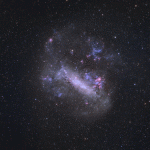
The IceCube telescope's optical detectors are deployed deep in the Antarctic ice. Credit: James Roth/University of Delaware
Scientists are using a giant block of ice to detect neutrinos.
The Higgs Boson has been a hot topic since its existence was confirmed using the Large Hadron Collider (LHC). But LHC, a manmade particle accelerator, has played an important role in other discoveries since its construction was completed in 2008.
There are natural accelerators out there, according to associate professor Jenni Adams from the University of Canterbury in New Zealand. “We know they’re out there, [because] we know there’ve been protons accelerated to high energies, but we don’t know where these protons are coming from,” she said at the International Conference on High Energy Physics.
When it comes to detecting these accelerators, the problem is the nature of the protons — they have a positive charge and there are lots of magnetic fields in the universe that can bend their paths and obscure their origin. However, there is a solution available to the scientists in the form of neutrinos.
“We know wherever those charged particles are produced, neutrinos will be produced as well,” Adams says. The neutrinos have a neutral charge, so they can point back to where they come from and enable the researchers to find the accelerators.
The detector Adams and her colleagues are using is known, very appropriately, as IceCube. It is the world’s largest telescope, with a cubic kilometre of ice, extending from 1.5 to 2.5 kilometres below the South Pole, at its core.
They have also installed light detectors down there, which will tell them if neutrinos are present. “When neutrinos interact in the ice they produce charged particles that then produce light and we can work out where the neutrinos have come from by detecting that light.”
However, the researchers need high-energy neutrinos in order to determine the location of these natural accelerators and study them. And while there are huge amounts of neutrinos out there at any point in time, they are either produced in our own atmosphere or are so weak that a huge detector is required just to capture a few of them.
When a star goes supernova, for example, it will produce millions of neutrinos. But during one of the last supernova, for example, the detectors were only able to capture about 14 neutrinos.
The existence of IceCube should change this. “If a supernova goes off in our galaxy now, we’ll actually detect hundreds of neutrinos with IceCube, but those neutrinos are actually going to be a lot lower energy than the ones we’re aiming for, so we won’t see them individually,” Adams says. Instead, the whole detector will light up, like a fireworks display.





